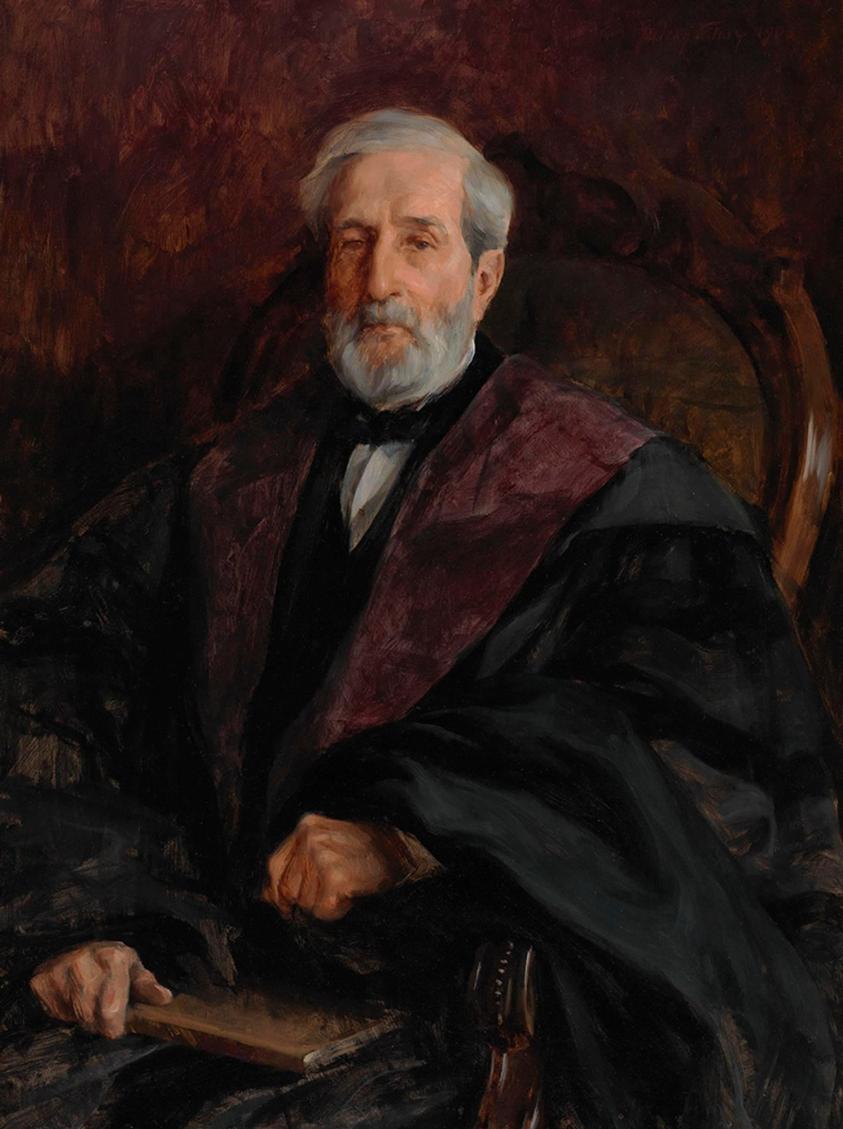
Artist:
Julian Story
(American, 1857 - 1919)
Sitter:
John Innis Clark Hare
John Innis Clark Hare
Medium: Oil on canvas
Date: 1903
Dimensions:
40 1/16 × 30 1/8 in. (101.8 × 76.5 cm)
Accession number: 2005.4.7
Curatorial RemarksJohn Innes Clark Hare gazes directly at the viewer, dressed in his jurist's black gown embellished with a dark crimson hood. Resting on his lap is a law book, alluding to his work as a judge. The color synthesis based on tones of black, gray, white and dark red in soft brushstrokes gives a sense of abstraction to a strong realistic image. In this introspective portrait, Julian Story intended to summarize the subject's long and successful career. John Innes Clark Hare was the son of Robert Hare of Philadelphia, a noted chemist and Harriet (Clark) Hare of Providence, Rhode Island. After being graduated with honors from the University of Pennsylvania in 1834, he studied chemistry under his father before changing to law. In 1841 he was admitted to the bar. The following year he married Esther Cox Binney, the daughter of the eminent lawyer, Horace Binney. John Hare's gentle personality and manners, his dignity, and exceptional abilities promised him an outstanding career. After an active practice of ten years, in 1851, he was elected to the district court of Philadelphia where he served for twenty-four years. In 1875 he became President Judge of Common Pleas Court No. 2 until his resignation in 1896 because of ill health. Hare also served as a trustee of the University of Pennsylvania and as a professor of law, eventually becoming Professor Emeritus of the Institute of Law. Judge Hare was admired and held in affection by both the public and his associates.
The son of noted neoclassical sculptor, William Wetmore Story, Julian Russell Story was born in Walton-on-Thames, England. Educated at Eton and Oxford University in England, he studied art in Paris under Gustave Boulanger, and Jules Fefebvre, and in Florence, Italy, under Frank Duveneck. He soon became a portrait painter of distinction, exhibiting both in Europe and the United States. In 1891, he married Emma Eames, a celebrated opera singer. She is remembered in a well-known portrait, "Madame Emma Eames" (Cincinnati Art Museum), one of his finest works.
Julian Story lived in Europe but divided his time among Italy, Paris, New York, and Philadelphia. He exhibited generously abroad and in the United States, receiving silver and gold medals in Paris, Berlin, and San Francisco. In Philadelphia, he painted leaders of the business and professional communities and their wives. He died there in 1919.
The son of noted neoclassical sculptor, William Wetmore Story, Julian Russell Story was born in Walton-on-Thames, England. Educated at Eton and Oxford University in England, he studied art in Paris under Gustave Boulanger, and Jules Fefebvre, and in Florence, Italy, under Frank Duveneck. He soon became a portrait painter of distinction, exhibiting both in Europe and the United States. In 1891, he married Emma Eames, a celebrated opera singer. She is remembered in a well-known portrait, "Madame Emma Eames" (Cincinnati Art Museum), one of his finest works.
Julian Story lived in Europe but divided his time among Italy, Paris, New York, and Philadelphia. He exhibited generously abroad and in the United States, receiving silver and gold medals in Paris, Berlin, and San Francisco. In Philadelphia, he painted leaders of the business and professional communities and their wives. He died there in 1919.